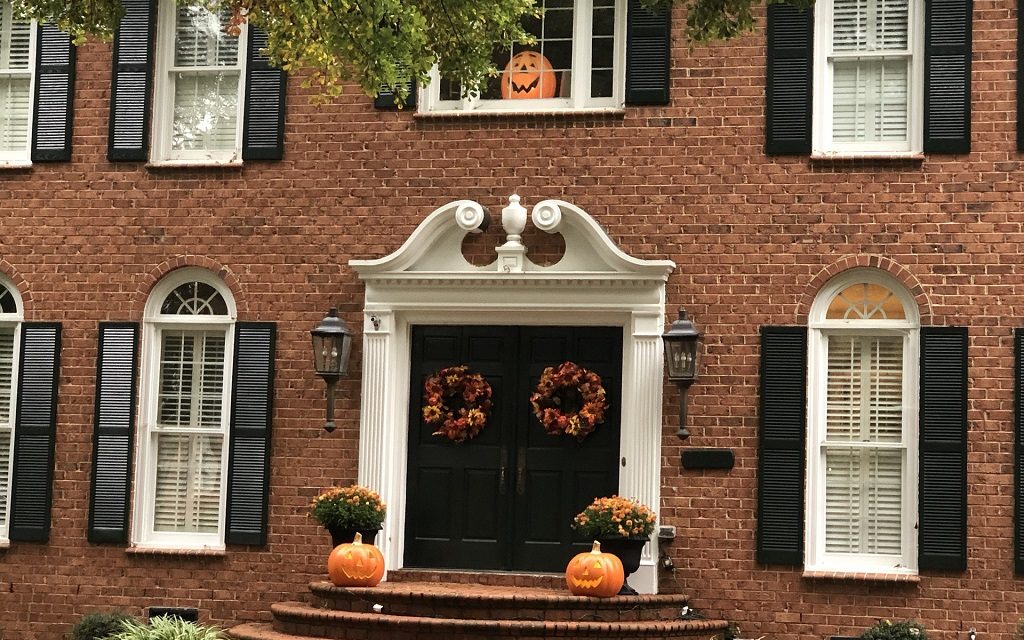Updated: October 18, 2023
Regardless of how one feels about Halloween, it is always interesting to take note of current trends as a barometer of how cultural norms and tastes have changed from previous eras.
Before sharing what has changed, we like to point out that Candy Corn forever remains the most polarizing of all Halloween candy. We appreciate Candy’s Store take on the often misunderstood sweet, which we believe puts the iconic candy in proper perspective.
To satisfy our own curiosity, we searched for updated stats, surveys, trivia and trends to assess the state of Halloween in the year 2023.
Here’s what we found.
Table of Contents
- Halloween Consumer Trends & Stats 2023
- Halloween Homeowners Insurance Scares
- Beware of Real Estate Non-Disclosures
- Halloween Trivia
- Halloween Tips & Resources for Homeowners
Also see:
- How to Protect Your Home from the “Creeping” Threat of Phrogging
- 19 Ideas That Will Elevate Your Entertaining Game!
- 10 Truly Special Online Christmas Decoration Stores
- 10 Patriotic and Americana Décor Ideas & Resources
- More Recommended Entertaining-at-Home Articles
- Related Topics: Entertaining-at-Home | Holidays | Protection & Safety for Your Home
Halloween Consumer Trends & Stats 2023
Halloween is the second largest commercial holiday after Christmas. Shopping periods for both Halloween and Christmas continue to expand, overtaking larger display space in retail stores. For example, Halloween continues to encroach on the Back-to-School/Fall shopping season, while Christmas displays, in turn, begin to appear before Thanksgiving and even Halloween.
For industry stats pertaining to Halloween shopping most, if not all, media outlets cite the same source: The National Retail Federation (NRF). Here are highlights from their 2023 Halloween report.
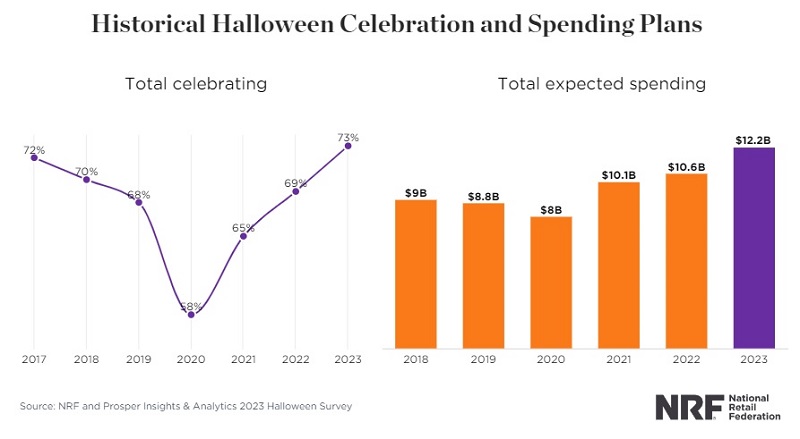
Image courtesy of NRF
Halloween 2023 Retail Statistics for the United States
73%
Percentage of US Consumers Planning to Celebrate Halloween: 73%
Almost three-quarters of American consumers plan to celebrate Halloween in 2023. This is an increase of 5.5% from the 2022 consumer participation level of 69%, and higher than the previous participation highs of 2012 and 2017, when the participation levels were 72%.
$12.2B
The total estimated amount that US consumers will spend on Halloween in 2023 is $12.2 billion dollars. This is a whopping 15% greater than last year’s record of $10.6B spent in 2022.
Breakdown of US Consumer Spending on Halloween
- Candy: $3.6B, 96% of Shoppers
- Costumes: $4.1B, 69% of Shoppers
- Decoration: $3.9B, 77% of Shoppers
- Greeting Cards: $0.5B, 35% of Shoppers
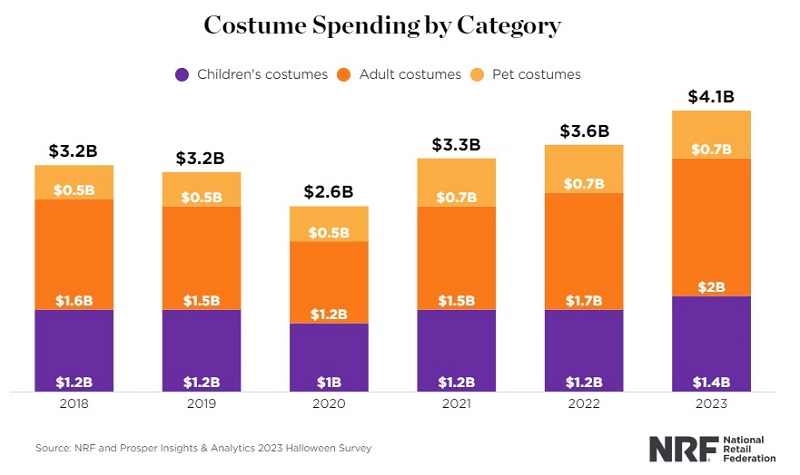
Image courtesy of NRF
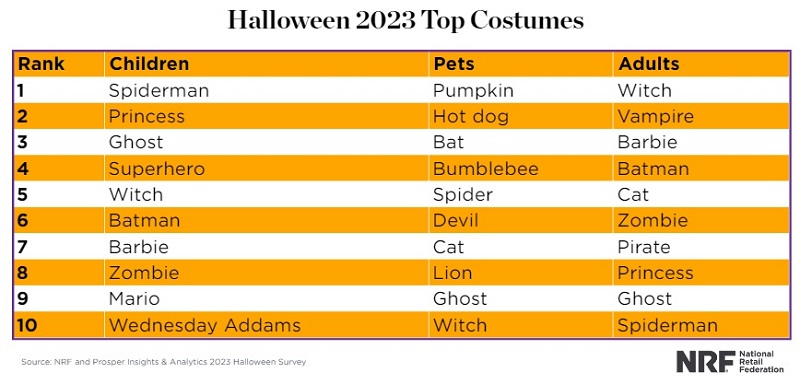
Image courtesy of NRF
Most Popular Halloween Activities
- Handing Out Candy: 68%
- Decorating the House or Yard: 53%
- Wearing a Costume: 50%
- Carving Pumpkins: 46%
- Hosting or Attending a Party: 32%
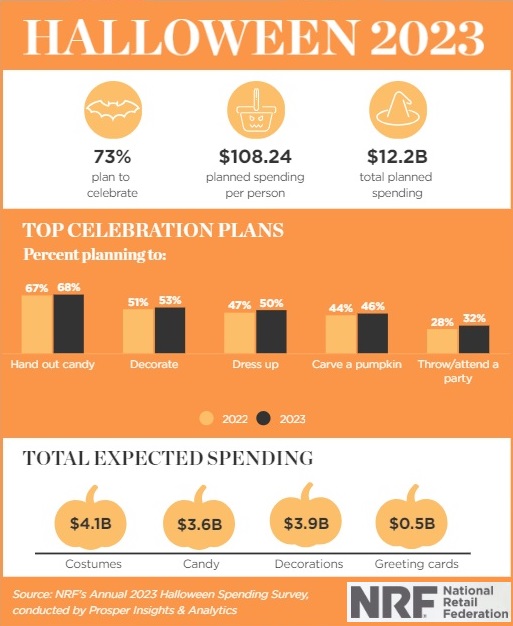
Image courtesy of the NRF
$2B
NRF estimates that $2 billion will be spent on Halloween costumes for adults, projected to rise a healthy 17.6% in 2023 to $2B versus spending in 2022 at $1.7B.
$700M
NRF estimates that $700 million will be spent on costumes for pets in 2023, flat for the last three years.
Where US Consumers Shop for Halloween
- Discount Stores: 40%
- Specialty Halloween/Costume Stores: 39%
- Online: 32%
- Grocery Stores/Supermarkets: 28%
- Departments Stores: 25%
- Crafts or Fabrics Stores: 13%
- Home Decor Storse: 13%
- Clothing Stores: 13%
- Thrift Stores/Resale Shops: 12%
- Local/Small Businesses: 10%
- Drug Stores: 8%
- Home Improvement Stores: 8%
- Greeting Card/Gift Stores: 8%
- Other: 4%
- Catalog: 3%
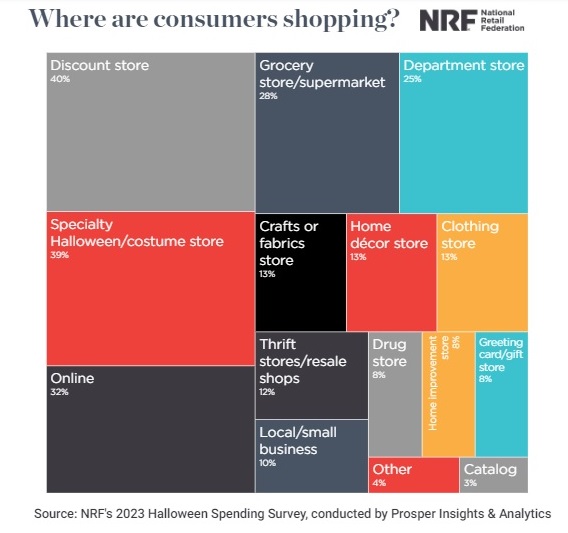
Image courtesy of NRF
Additional Halloween Metrics for Other Time Frames or from Other Sources
82%
The percentage of US Households with Children that celebrated Halloween in 2021. (Source: NRF)
55%
The percentage of US Households without Children that celebrated Halloween in 2021. (Source: NRF)
130M
The latest estimated number of homes or apartments where people live and are possible places for trick-or-treaters to visit according to the US Census in 2022.
73.1M
The number of total potential US Trick-or-Treaters, estimated by the number of children under age 18 in 2020 from the US Census.
41M
The number of total potential US Trick-or-Treaters, estimated by the number of children under aged 5 to 14 in 2022 from the US Census.
1,200
The estimated number of professional Haunted Attractions in the US according to AmericaHaunts.com. They also list that there are 300 theme parks that operate horror-themed events and over 3,000 charity-run “spook shows”.
100
The approximate number of countries that celebrate Halloween according to AmericaHaunts.com.
700
The estimated number of formal wear and costume rental establishments in the United States as of 2021 according to the US Census, down from 843 in 2019.
3,227
The number of US confectionery and nut stores in 2021, according to the US Census, down from 3,320 in 2020.
1/4
The portion of ALL candy sold annually in the U.S. that is purchased for Halloween, according to History.com.
Also see:
Halloween Homeowners Insurance Scares
The 4 Most Common Horrors for Homeowners on Halloween
November 1st is a very busy day for insurance adjusters. The four most perilous horrors for homeowners during Halloween night are:
- Unexpected Fires
- Vandalism or Theft
- Injuries on Your Property
- Dog Bites
The good news is that all of these types of incidents are covered under most standard insurance policies.
When Violent Crimes Most Occur on Halloween
According to EMC Security, statistically, most violent crimes occur between 7 pm and 1 am, peaking at 10 pm – the times also favored by trick-or-treaters on Halloween.
Beware of Real Estate Non-Disclosures
9
The number of states that have laws around the disclosure of a death on the property:
- California requires disclosure if the death occurred within 3 years of the sale
- Alaska requires disclosure within 1 year of the sale
- South Dakota requires discloser of homicides only
- The following states require disclosure only if asked: Connecticut, Delaware, Georgia, New Hampshire, New Jersey and South Carolina
4
The number of states that specifically mention paranormal activity in their real estate disclosure laws: Massachusetts, Minnesota, New Jersey and New York.
- Massachusetts and Minnesota both declare that paranormal activity is unnecessary to disclose
- New Jersey requires disclosure only if asked by prospective buyers
- New York requires that sellers must disclose only if they had previously disclosed activity publicly
The Ghostbusters Ruling
A New York state ruling from 1991 that ruled in favor of an out-of-town homebuyer that the seller failed to disclose a ghost. The buyer was allowed to back out of the contract and was returned the down payment. Locals knew about the home’s haunted reputation. In fact, the original owner of the disputed house had previously advertised it as a haunted attraction for paranormal enthusiasts. However, this knowledge was not widely known outside of the local community.
Also see:
Halloween Trivia
30,581
The number of lit jack-o’-lanterns on display by the town of Keene, New Hampshire that set the Guinness world record in October 2013.
1927
According to FactRetriever.com, the first known mention of trick-or-treating in print in North America occurred in 1927 in Blackie, Alberta, Canada.
Black & Orange
According to the Library of Congress, black and orange as the official colors of Halloween traces back to the Celtic festival of Samhain. For the Celts, black represented the end of summer while orange symbolized the autumn harvest season.
“Home Haunters”
“Home Haunters” is the nickname given to Halloween enthusiasts who create Halloween attractions at home simply for the love of it.
For more Halloween trivia also see:
Halloween Tips & Resources for Homeowners
The most important advice for homeowners that plan on giving out candy on Halloween night is to make sure that the approach to your property and front door is safe and free of hazards, especially for young children. Homeowners should test out the walkway to their front door several nights prior to Halloween so they have ample time to make any necessary corrections. Be sure to conduct your review under similar circumstances as Halloween night (e.g. same time of day with all planned special effects and lighting turned on). It is prudent to have ample outdoor lighting instead of trying to create an overly dark, scary atmosphere that is less safe to visitors.
For homeowners not planning to give out candy or who will not be home, be sure to keep your outdoor lights off, as this is a well-known signal that candy is not being offered at the given home.
Also see these helpful Halloween resources:
- Nextdoor Trick-Or-Treat Neighborhood Map
- Suggested Start Times for Trick-Or-Treating by City
- Make Halloween Fun and Safe with These Tips for Celebrating
- How to Throw a Halloween Party on a Budget
More Recommended Entertaining-at-Home Articles
- 9 Creative Themes for Hosting a Memorable Social Event at Home
- Find Interesting Event Spaces in Your Neighborhood
- Important Legal Documents for Entertaining at Home
- On-Demand Bartender Machines for Perfect Cocktails & Easy Hosting
- What to Know About Using a Transformer Table for Entertaining
- 5 Products That Are Invaluable for Entertaining During the Holidays
- Find a Nearby Swimming Pool to Rent by the Hour
- How to Host a Culinary Event
| Purgula is reader-supported. When you click on links to other sites from our website, we may earn affiliate commissions, at no cost to you. If you find our content to be helpful, this is an easy way for you to support our mission. Thanks! Learn more. |

